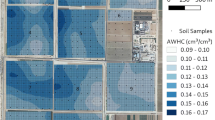Summary
Corn yields for full irrigation and 4 different levels of deficit irrigation were simulated using a model developed by Stockle and Campbell (1985). Different irrigation levels were obtained by holding the application depth constant and allowing the irrigation interval to vary from 1 to 5 days. Silt loam and loamy sand soils, two root depths, two water contents at planting time, total pumping heads ranging from 0 to 800 m, four ratios of energy cost to commodity price and climatic data for the 1974 growing season at Davis, California were examined. The different variable combinations resulted in a wide range of crop water deficit and yield. Results indicated that, for given combinations, slight deficit (ratios of actual to potential transpiration larger than 0.89) provided higher net benefit than full irrigation. Larger deficits were never advantageous across the diverse range of conditions examined, indicating that potential benefits are associated with only a narrow range of irrigation deficits. This result illustrates the risk involved when deficit irrigation is practiced. Large soil water holding capacity, high soil water contents at planting and deep root exploration were found important for successful implementation of deficit irrigation. Total pumping head and the ratio of energy cost to commodity price were important factors in determining the feasibility of deficit irrigation for the conditions examined. It was also found that the level of irrigation which maximized net benefits tended to be lower for situations where the quantity of water available for irrigation was fixed and the amount of land which could be irrigated was unlimited than when there was sufficient water to fully irrigate the entire farm. Situations where deficit irrigation is a more effective way of reducing energy cost than reducing system operating pressure were ob served.
Similar content being viewed by others
References
English MJ, James LG, Hunsaker DH, Mc Kusick RJ (1985) A practical view of deficit irrigation. Paper 85-2595. ASAE Winter Meeting, Chigago, Illinois, Dec. 17–20
Hexum RW, Heady EO (1978) Water production functions and irrigated agriculture. Iowa State University Press, Ames
James LG (1982) Modeling the performance of center pivot irrigation systems operating on variable topography. Trans ASAE 25:143
Miller DE, Aarstad JS (1976) Yield and sugar content of sugarbeets as affected by deficit high-frequency irrigation. Agron J 68:231
Priestly CHB, Taylor RJ (1972) On the assessment of surface heat flux and evaporation using large-scale parameters. Mon Weather Rev 100:81
Stegman EC, Musick JT, Stewart JI (1980) Irrigation water management. In: Jensen ME (ed) Design and operation of farm irrigation systems. Monograph No. 3, ASAE, St. Joseph, Michigan, pp 763–816
Stern J, Bresler E (1983) Nonuniform sprinkler irrigation and crop yield. Irrig Sci 4:17
Stewart JI, Hagan RM (1973) Functions to predict effects of crop water deficits. J Irrig Drain Div, ASCE 99 (IR4):421
Stockle CO, Campbell GS (1985) A simulation model for predicting effect of water stress on yield: an example using corn. In: Hillel D (ed.). Advances in Irrigation, vol 3. Academic Press, New York, p 283
Texas Agricultural Extension Service (1986) Texas crop enterprise budgets. Texas A&M University System, College Station, Texas
Vaux HJ Jr, Pruitt WO (1983) Crop-water production functions. In: Hillel D (ed). Advances in irrigation, vol 2. Academic Press, New York, p. 61
Author information
Authors and Affiliations
Additional information
Scientific Paper No. 7571 Project 0634, College of Agriculture and Home Economics, Washington State University, Pullman, WA 99164-6120, USA
Rights and permissions
About this article
Cite this article
Stockle, C.O., James, L.G. Analysis of deficit irrigation strategies for corn using crop growth simulation. Irrig Sci 10, 85–98 (1989). https://doi.org/10.1007/BF00265686
Received:
Issue Date:
DOI: https://doi.org/10.1007/BF00265686




